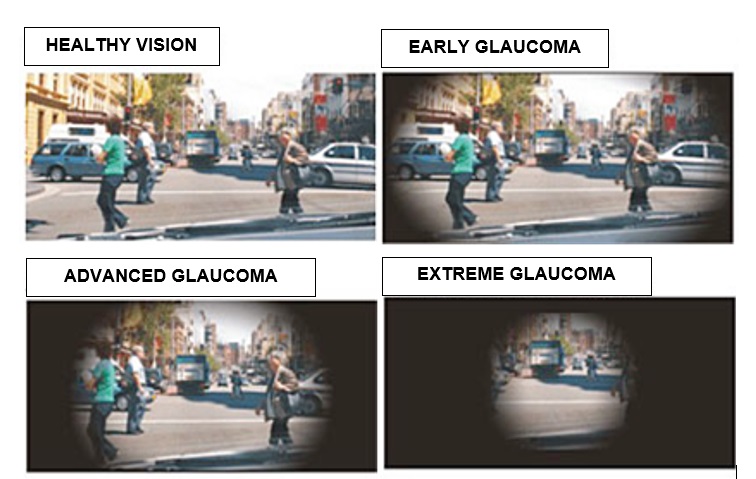Can glaucoma be cured?
Glaucoma is an eye condition in which the optic nerve (nerve that carries visual signals from your eye to your brain) gets damaged. Hence, peripheral vision gets impacted. Initially, there may be no symptoms of glaucoma. However, as time progresses, you may have only a small area of central vision (tunnel vision) left or even have permanent vision loss. This article explores whether or not glaucoma can be cured.
There are two main types of glaucoma: open angle glaucoma and angle closure glaucoma. The ‘angle’ pertains to the drainage angle at the front of your eye which allows fluid to drain from your eye.

We try to answer: Can glaucoma be cured?
While the damage due to glaucoma is irreversible, treatment and regular eye check ups can help retard or prevent a loss of vision, particularly when you develop glaucoma in its early stages.
Treatment for glaucoma includes lowering your intraocular pressure (eye pressure). Your doctor may recommend treatment such as a combination of prescription eye drops, oral medications, laser treatment or surgery, based on your condition.
Eyedrops
Prescription eye drops can reduce eye pressure by enhancing the process of fluid drainage from your eye or by decreasing the amount of fluid your eye makes. There are various kinds of eye drops that can be prescribed based on the degree of your eye pressure.
Do note that, however, as with any drug or vaccine administered, there would be side effects. In the case of such eyedrops, side effects include blurred vision, fatigue, lower or higher blood pressure, breathing challenges and even impotence. If your doctor has given you multiple eye drops to use, wait 5 to 10 minutes between each drop when you self-administer these drops into your eyes.
Oral medications
If your eye pressure does not go down to the desired level despite eye drops, an oral medication, typically a carbonic anhydrase inhibitor, can help do so. Frequent urination, depression, stomach upset, and kidney stones are some of the side effects that come with these medications. Please check with the doctor prescribing these medications and/or your regular doctor for any concerns you may have.
Surgical procedures
Laser therapy and various surgical procedures can enhance the drainage of fluid within the eye to reduce eye pressure:
- Laser therapy. Laser trabeculoplasty can address open-angle glaucoma. During this procedure, your doctor uses a small laser beam to unclog channels in the trabecular meshwork.
- Filtering surgery. This surgical procedure is called a trabeculectomy whereby your surgeon makes an opening in the sclera (white portion of your eye covered by your eyelids) and removes part of the trabecular meshwork.
- Drainage tubes. Your eye surgeon installs a small tube shunt in your eye to drain away excess fluid to lower your eye pressure via this procedure.
- Minimally invasive glaucoma surgery (MIGS). A MIGS procedure typically requires less immediate postoperative care and carries less risk than trabeculectomy or installing a drainage device. MIGS procedures usually are done with cataract surgery. Discuss about the most suitable procedure with your doctor.
You might have to constantly consult with your doctor for follow-up examinations after surgical procedures are done. Moreover, you may eventually need to undergo more procedures if your eye pressure continues to rise or if you experience other eye changes.
Laser peripheral iridotomy to treat acute angle-closure glaucoma
Acute angle-closure glaucoma is a medical emergency. Urgent treatment is necessary to reduce the pressure in your eye when you have this condition. Such treatment generally includes laser, medication and other surgical procedures.
Laser peripheral iridotomy is a procedure to address acute angle-closure glaucoma. This procedure involves your doctor creating a small opening in your iris using a laser. By doing so, your doctor would then create space for fluid (aqueous humor) to flow through it to mitigate eye pressure.
Schedule regular eye checkups with your doctor to detect early signs of glaucoma. Use the planoApp to book an eye appointment using planoEyecheck. It is also important to discuss with your eye health professional on which of the above-mentioned strategies to potentially cure glaucoma should you be undergoing.
References
Mayoclinic.org. 2021. Glaucoma – Diagnosis and treatment – Mayo Clinic. [online] Available at: <https://www.mayoclinic.org/diseases-conditions/glaucoma/diagnosis-treatment/drc-20372846> [Accessed 29 November 2021].
Tools Designed for Healthier Eyes
Explore our specifically designed products and services backed by eye health professionals to help keep your children safe online and their eyes healthy.

